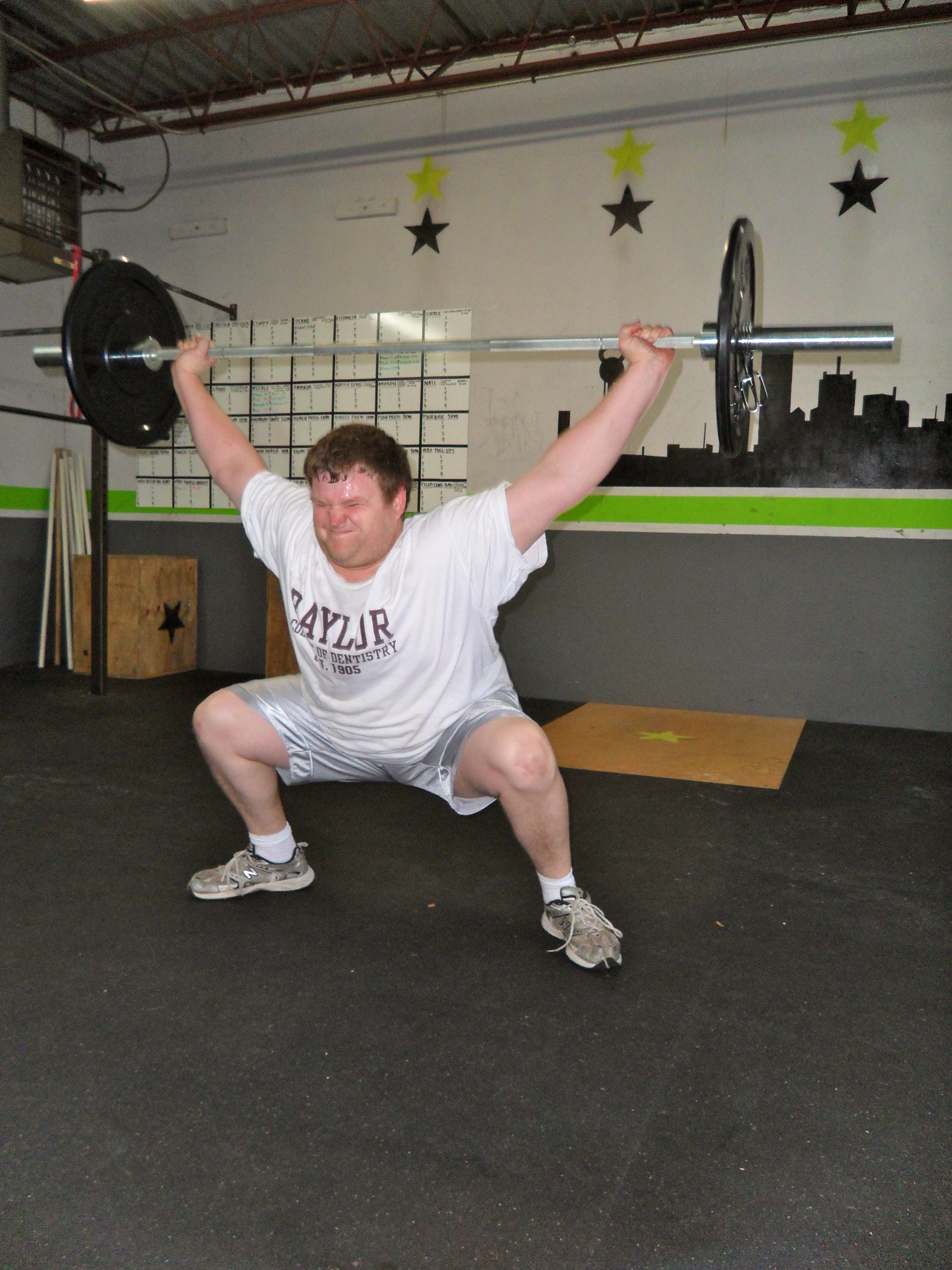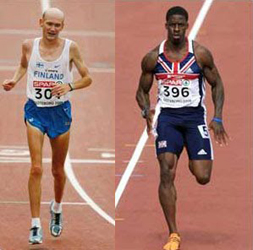Hang Squat Snatch
2-2-2-2-2 (try to exceed what you hit last Thursday)
For time:
– 400 m run
– 15 Power snatches (115/75-95/65-65/35)
– 20 Burpees
– 15 Power snatches
– 400 m run
Hang Squat Snatch
2-2-2-2-2 (try to exceed what you hit last Thursday)
For time:
– 400 m run
– 15 Power snatches (115/75-95/65-65/35)
– 20 Burpees
– 15 Power snatches
– 400 m run
So “Nicole” came and went on Monday. It’s safe to say that many of you are still feeling some residual soreness from all of the pull-ups. Let’s talk about soreness for a minute. Soreness is cause by micro-trauma, or small tears, in the muscles due to constant stimulation. After this breakdown, the muscle restructures and grows larger which is also known as hypertr0phy. The muscle will grow bigger and stronger given the correct nutritional and recovery conditions. So soreness is expected on some levels. The technical term for a more delayed soreness response is Delayed Onset Muscle Soreness. DOMS can start anywhere between 8-24 hours and may peak around 24-72 hours post exercise. Pain with DOMS is usually only felt when the muscle is stretched or put under pressure. If you have a muscle that is hurting while at rest, it may be due to a pull or strain and should be dealt with accordingly. DOMS is more closely associated with a more eccentric loading of the muscles. This is when the muscle is lengthened while being contracted. The onset of soreness is different for every individual and will vary depending on the type of workout and level of fitness. So how do you address soreness before and after it hits?
Prevention
– Make sure to perform a more dynamic warm-up and try to stay away from static stretches.
– Focus on specific movements or joint angles that are present in the WOD when warming up.
– Cool down, stretch, foam roll, and/or trigger point post WOD paying close attention to any problem areas.
Relief
– If soreness is really bad, don’t be afraid to ice or take some anti inflammatory medication.
– Make sure to stick to a an anti inflammatory diet such as the Paleo diet and be weary of grains or sugars that will spike the insulin response.
– Drink tons of water. Drink until you feel like your teeth are floating. This will help remove toxins.
– Wear compression gear during or after the WOD for recovery to promote blood flow to sore areas.
– Low-intensity activities such as yoga, walking, or swimming can help muscles heal faster by increasing blood flow to the muscles.
Four sets of:
Good mornings x 5-7 reps – slow and controlled
Rest 20 seconds
Push-Ups x 10-25 reps @ 1010 – C2G if able
Rest 3 minutes;
then…
5 rounds of:
– 7 burpees
– 20 double unders
– 50 m sprint (walk back)
*rest 1.5 minutes when you get back to the gym
A little look into the 3 position snatch drill performed yesterday…
Is there anything that you see that these two athletes can do differently?
—————-
FREE Saturday morning WOD @10am
South Central Regionals this weekend in San Antonio. If you haven’t checked out the workouts, they are brutal!!
A. Hang Power Clean x1/Push Press x 3/Jerk x 1; rest 2 minutes x 3
B. On an 18 min countdown timer:

“An evolving journey and exploration of the connection between spirit, mind and body WHILE attempting to discover physical potential WHILE leading to discovering purpose and producing longevity of oneself.”
– James Fitzgerald
Part I of this series of post can be found here.
The metabolic pathways. To understand fitness at a biological level you must have basic knowledge of the 3 metabolic pathways which provide the body with energy to perform. They are known as the phosphocreatine, glycolytic, and oxidative pathways. The first pathway, the phosphocreatine system, provides sources of energy in very short yet intense bouts. Think of it as picking something heavy up just one time, sort of like a one rep max. Since the body does not have time to react, take in oxygen, and produce ATP, it relies on a readily available storage of phosphocreatine found in the muscles. The kicker is that there is not very much of it and after about 10 or so seconds your storage is up and the second energy system kicks in, the glycolytic pathway. The glycolytic system is the most commonly associated with more moderate levels of training (going off the notion that a 1RM is a high level). This is where the majority of CrossFit WODs are performed at. This system operates both aerobically and anaerobically. The more efficient you are anaerobically, the faster you can work through a given time frame (higher power output). The more power you produce, the more that favorable adaptation will occur. This is where the good stuff is, where fat storages are tapped into and lean muscle building thrives. The glycolytic system works up to about 10 minutes in duration. If the intensity is lower than it takes for the glycolytic system to initiate, the aerobic or oxidative pathway takes over. Long, sustainable energy output like that used on long runs or bike rides is due to the oxidative pathway. This system’s main source of energy is carbohydrates found in the blood, liver, and muscles and needs a constant supply of oxygen to maintain ATP output. If you were to be on a long run and suddenly a dog starts chasing you out of no where, you can bet the primary energy system in use would switch back from oxidative to glycolytic. Below is a graph explaining the three energy systems’ production as a function of time.
Note: the glycolytic system is referred to as the “Lactic Acid System” in this graph.

What does this have to do with fitness? Greg Glassman says is best:
“Total fitness, the fitness that CrossFit promotes and develops, requires competency and training in each of these three pathways or engines. Balancing the effects of these three pathways largely determines the how and why of the metabolic conditioning or “cardio” that we do at CrossFit.”
Anaerobic training. Interval training is the key to developing the cardiovascular system without loses in strength, power and speed. Just ask co-owner Ben O. who recently finished his first marathon well under 4 hours largely due to interval training and not a lot of the typical longer, more aerobic training. Interval training can be done in a variety of ways with added rest or shortened time intervals of high effort. If you train more in the anaerobic zone, you will see benefits in both strength and endurance (oxidative system). Training in the oxidative zone will not yield benefits to strength, speed and power. Look at the bodies of these two completely different types of runners and tell me which you think looks healthier and better suited for a more well-rounded performance.

It is important to regularly vary combinations of rest, work and repetitions when training with interval patterns. Lucky for you, this is what we do everyday at the box.
Front Squat 1RM
5-3-3-1-1-1
then…
1-1-1-1-1
* move up in weight if able
50 TGUPs NOT for time
– pick the heaviest weight you can
Build up to a heavy Jerk in 4-5 tries
then…
“J-Hard is 26”
4 rounds of:
– 26 lunges (13 each leg)
– 26 KB swings (1.5/1)
– 26 abmat sit-ups
*rest 2, 3, and 4 min after rounds. Go hard!